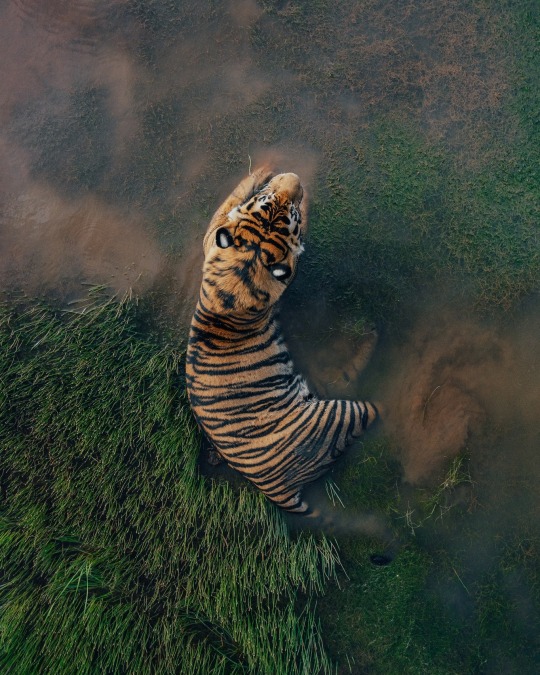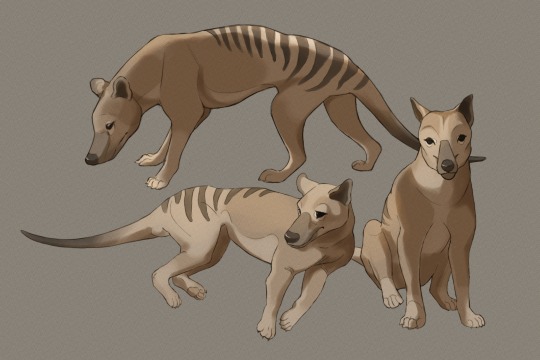#tiger wildlife
Explore tagged Tumblr posts
Text
Cute tiger drinking water
(Source)
#tiger#tigers#water#cute#nature#wildlife#wild animals#aww#wholesome#cute animals#drinking water#drinking#video#babyanimalgifs
5K notes
·
View notes
Text
Camera-trapping data revealed in a new study show a steady recovery of tigers in Thailand’s Western Forest Complex over the past two decades.
The tiger recovery has been mirrored by a simultaneous increase in the numbers of the tigers’ prey animals, such as sambar deer and types of wild cattle.
The authors attribute the recovery of the tigers and their prey to long-term efforts to strengthen systematic ranger patrols to control poaching as well as efforts to restore key habitats and water sources.
Experts say the lessons learnt can be applied to support tiger recovery in other parts of Thailand and underscore the importance of the core WEFCOM population as a vital source of tigers repopulating adjacent landscapes.
The tiger population density in a series of protected areas in western Thailand has more than doubled over the past two decades, according to new survey data.
Thailand is the final stronghold of the Indochinese tiger (Panthera tigris corbetti), the subspecies having been extirpated from neighboring Cambodia, Laos and Vietnam over the past decade due to poaching, habitat loss and indiscriminate snaring...
Fewer than 200 tigers are thought to remain in Thailand’s national parks and wildlife sanctuaries, only a handful of which are sufficiently undisturbed and well-protected to preserve breeding tigers.
The most important of these protected areas for tigers is the Huai Kha Khaeng Thung Yai (HKK-TY) UNESCO World Heritage Site, which comprises three distinct reserves out of the 17 that make up Thailand’s Western Forest Complex (WEFCOM). Together, these three reserves — Huai Kha Khaeng Wildlife Sanctuary, Thungyai Naresuan West and Thungyai Naresuan East — account for more than a third of the entire WEFCOM landscape.
Now, a new study published in Global Ecology and Conservation documents a steady recovery of tigers within the HKK-TY reserves since camera trap surveys began in 2007. The most recent year of surveys, which concluded in November 2023, photographed 94 individual tigers, up from 75 individuals in the previous year, and from fewer than 40 in 2007.
Healthy tiger families

The study findings reveal that the tiger population grew on average 4% per year in Hua Kha Khaeng Wildlife Sanctuary, the largest and longest-protected of the reserves, corresponding to an increase in tiger density from 1.3 tigers per 100 square kilometers, to 2.9 tigers/100 km2.
“Tiger recoveries in Southeast Asia are few, and examples such as these highlight that recoveries can be supported outside of South Asia, where most of the good news [about tigers] appears to come from,” said Abishek Harihar, tiger program director for Panthera, the global wildcat conservation organization, who was not involved in the study.
Among the camera trap footage gathered in HKK-TY over the years were encouraging scenes of healthy tiger families, including one instance of a mother tiger and her three grownup cubs lapping water and lounging in a jacuzzi-sized watering hole. The tiger family stayed by the water source for five days during the height of the dry season.
The team of researchers from Thailand’s Department of National Parks, Wildlife and Plant Conservation, the Wildlife Conservation Society, Kasetsart University, and India’s Center for Wildlife Studies deployed camera traps at more than 270 separate locations throughout the HKK-TY reserves, amassing 98,305 days’ worth of camera-trap data over the 19-year study period.
Using software that identifies individual tigers by their unique stripe patterns, they built a reference database of all known tigers frequenting the three reserves. A total of 291 individual tigers older than 1 year were recorded, as well as 67 cubs younger than 1 year [over the course of the study].
Ten of the tigers were photographed in more than one of the reserves, indicating their territories straddled the reserve boundaries. The authors conclude that each of the three reserves has a solid breeding tiger population and that, taken together, the HKK-TY landscape is a vital source of tigers that could potentially repopulate surrounding areas where they’ve been lost. This is supported by cases of known HKK-TY tigers dispersing into neighboring parts of WEFCOM and even across the border into Myanmar.
Conservation efforts pay off
Anak Pattanavibool, study co-author and Thailand country director at the Wildlife Conservation Society, told Mongabay that population models that take into account the full extent of suitable habitat available to tigers within the reserves and the likelihood that some tigers inevitably go undetected by camera surveys indicate there could be up to 140 tigers within the HKK-YT landscape.
Anak told Mongabay the tiger recovery is a clear indication that conservation efforts are starting to pay off. In particular, long-term action to strengthen systematic ranger patrols to control poaching as well as efforts to boost the tigers’ prey populations seem to be working, he said.
“Conservation success takes time. At the beginning we didn’t have much confidence that it would be possible [to recover tiger numbers], but we’ve been patient,” Anak said. For him, the turning point came in 2012, when authorities arrested and — with the aid of tiger stripe recognition software — prosecuted several tiger-poaching gangs operating in Huai Kha Khaeng. “These cases sent a strong message to poaching gangs and they stopped coming to these forests,” he said."
...ranger teams have detected no tiger poaching in the HKK-TY part of WEFCOM since 2013.
-via Mongabay News, July 17, 2024
#tigers#thailand#thai#endangered species#big cats#conservation#wildlife#wildlife conservation#wildlife photography#poaching#good news#hope
2K notes
·
View notes
Text
#tiger#tigers#wild cats#exotic cats#animals#beautiful animals#nature#exotic animals#wild animals#wildlife#wild world#yolas0
1K notes
·
View notes
Text
2K notes
·
View notes
Text

(discovery)
2K notes
·
View notes
Text

A tiger quoll (Dasyurus maculatus) at night in Australia
by Mark Sanders
#tiger quoll#quolls#marsupials#dasyurus maculatus#dasyurus#dasyuridae#dasyuromorpha#marsupialia#mammalia#chordata#wildlife: australia#wildlife: oceania
699 notes
·
View notes
Text


Eğer yüreğinizde merhametle beslenen bir sevgi varsa. asla korkmayın çünkü zararsız bir sevgi sizi güçlendirir..
Love is a matter of courage..
#my photography#landscape#photography#yörüngede#artists on tumblr#cottagecore#aesthetic#popular#flowers#tiger#animals#gifs#sensory#fluffy#tigre#wild#wildlife#RadarPlz#travel#room#home#design#reading#literature#pets#architecture#nature#books#books and libraries#study
2K notes
·
View notes
Text

Thylacine studies from the colorized footage.
#thylacine#tasmanian tiger#tasmania#extinct species#extinct animals#wildlife illustration#wildlife art#marsupial#animal art#zoology#animal studies#animal artist#tasmanian wolf#australia#australian wildlife#australian animals
770 notes
·
View notes
Photo

Roaring Colors: Niv Bavarsky's Vibrant Depiction of a Tiger
930 notes
·
View notes
Text

Resting in dappled shade
#tigers#tim dennis#canon#photographers on tumblr#photography#lensblr#tim dennis.tumblr#70d#canon 70d#original photographers#animal#chester zoo#zoo#big cats#tiger#wildlife#shade
245 notes
·
View notes
Text
"In a historic step toward the first-ever restoration of the tiger population to a nation where they were once extinct, two captive Siberian tigers have been translocated from Anna Paulowna Sanctuary, Netherlands, to the Ile-Balkhash Nature Reserve in Kazakhstan.
This remarkable event is part of an ambitious program led by the Government of Kazakhstan with support from WWF and the UN Development Program to restore the Ile-Balkhash delta ecosystem and reintroduce tigers to the country and region, where the species has been extinct for over 70 years.
“It is a high priority for Kazakhstan to work on the restoration of rare species. For ecological value it is important that our biodiversity chain is restored. And that the tiger that once lived in this area is reintroduced here,” said Daniyar Turgambayev, Vice-minister of the Ministry of Ecology and Natural Resources of Kazakhstan.
In the early 21st century, genetic studies were carried out on bones and furs held in national collections which revealed that the population of tigers living between Iran, southern Russia, Central Asia, and the areas around the Caspian Sea was extremely similar to Siberian tigers.
This led scientists to conclude that Felis vigrata, the former name of the Caspian tiger, was simply the Siberian tiger that developed into a distinct population, but not a new subspecies, over generations of being separated by habitat fragmentation.
Bodhana and Kuma, the male and female tigers, will be housed in a spacious semi-natural enclosure of three hectares [7.4 acres] within the Ile-Balkhash Nature Reserve. Any of their offspring will be released into the wild and will become the first tigers to roam Kazakhstan in decades, and potentially the first-ever international tiger reintroduction.
They will play an important role in the establishment of a new tiger population in the region where they had previously been wiped out as a result of excessive hunting.
“Today marks a monumental conservation milestone to bring tigers back to Kazakhstan and Central Asia,” said Stuart Chapman Leader of WWF Tigers Alive. “This tiger translocation is a critical step to not only bring back the big cat to its historic homeland but also to rewild an entire ecosystem.”
Progress towards restoration of the area is already well underway with recovering and reintroduction of critical tiger prey species like the Kulan (Asiatic wild ass), and reforestation of over 120 acres with native trees. Being the apex predator, tigers will play a significant role in sustaining the structure and function of the ecosystem on which both humans and wildlife rely...
“With the launch of the tiger reintroduction program, we have witnessed a significant change—the revival of nature and our village of Karoi,” said Adilbaev Zhasar, the head of the local community group Auyldastar.
“This project not only restores lost ecosystems, but also fills us with pride in participating in a historic process. Because of small grants from WWF, we have the opportunity to do what we love, develop small businesses, and create jobs in the village, which brings joy and confidence in the future.”
From the very beginning, the local community around Ile-Balkhash Nature Reserve has been closely involved in the project. This includes support for improved agricultural techniques and the future development of nature tourism in the area.
The translocation of these tigers is the first of several planned in the coming years, with a goal to build a healthy population of about 50 wild tigers by 2035, starting with this pioneering pair for breeding. This initiative is not only a testament to the resilience of the species but also a powerful example of governments, conservation organizations, and local communities cooperating in wildlife and nature conservation."
-via Good News Network, November 27, 2024
#tiger#tigers#big cats#wild cats#kazakhstan#asia#central asia#biodiversity#endangered species#conservation#rewilding#wildlife conservation#ecology#nature reserve#good news#hope
1K notes
·
View notes
Text
#tiger#tigers#wild cat#exotic cat#big cat#animals#beautiful animals#nature#wild animals#wildlife#wild world#yolas0
885 notes
·
View notes
Text
736 notes
·
View notes
Text


(by sascha.fonseca)
2K notes
·
View notes